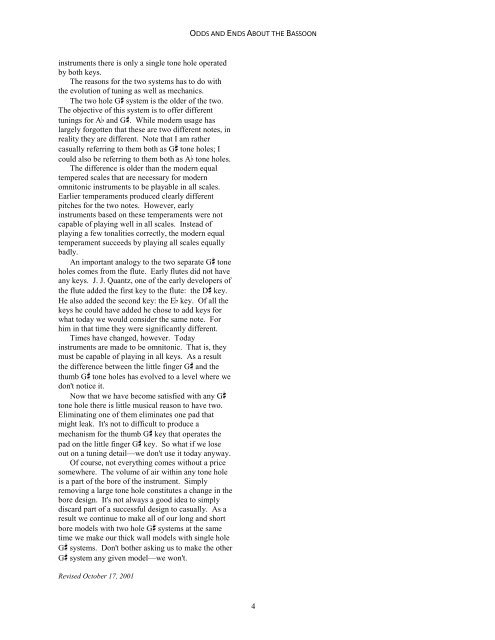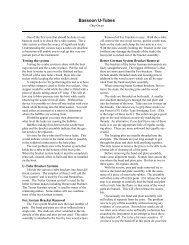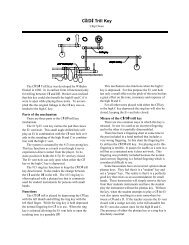Odds and Ends About the Bassoon - Fox Products
Odds and Ends About the Bassoon - Fox Products
Odds and Ends About the Bassoon - Fox Products
You also want an ePaper? Increase the reach of your titles
YUMPU automatically turns print PDFs into web optimized ePapers that Google loves.
instruments <strong>the</strong>re is only a single tone hole operated<br />
by both keys.<br />
The reasons for <strong>the</strong> two systems has to do with<br />
<strong>the</strong> evolution of tuning as well as mechanics.<br />
The two hole G' system is <strong>the</strong> older of <strong>the</strong> two.<br />
The objective of this system is to offer different<br />
tunings for A( <strong>and</strong> G'. While modern usage has<br />
largely forgotten that <strong>the</strong>se are two different notes, in<br />
reality <strong>the</strong>y are different. Note that I am ra<strong>the</strong>r<br />
casually referring to <strong>the</strong>m both as G' tone holes; I<br />
could also be referring to <strong>the</strong>m both as A( tone holes.<br />
The difference is older than <strong>the</strong> modern equal<br />
tempered scales that are necessary for modern<br />
omnitonic instruments to be playable in all scales.<br />
Earlier temperaments produced clearly different<br />
pitches for <strong>the</strong> two notes. However, early<br />
instruments based on <strong>the</strong>se temperaments were not<br />
capable of playing well in all scales. Instead of<br />
playing a few tonalities correctly, <strong>the</strong> modern equal<br />
temperament succeeds by playing all scales equally<br />
badly.<br />
An important analogy to <strong>the</strong> two separate G' tone<br />
holes comes from <strong>the</strong> flute. Early flutes did not have<br />
any keys. J. J. Quantz, one of <strong>the</strong> early developers of<br />
<strong>the</strong> flute added <strong>the</strong> first key to <strong>the</strong> flute: <strong>the</strong> D' key.<br />
He also added <strong>the</strong> second key: <strong>the</strong> E( key. Of all <strong>the</strong><br />
keys he could have added he chose to add keys for<br />
what today we would consider <strong>the</strong> same note. For<br />
him in that time <strong>the</strong>y were significantly different.<br />
Times have changed, however. Today<br />
instruments are made to be omnitonic. That is, <strong>the</strong>y<br />
must be capable of playing in all keys. As a result<br />
<strong>the</strong> difference between <strong>the</strong> little finger G' <strong>and</strong> <strong>the</strong><br />
thumb G' tone holes has evolved to a level where we<br />
don't notice it.<br />
Now that we have become satisfied with any G'<br />
tone hole <strong>the</strong>re is little musical reason to have two.<br />
Eliminating one of <strong>the</strong>m eliminates one pad that<br />
might leak. It's not to difficult to produce a<br />
mechanism for <strong>the</strong> thumb G' key that operates <strong>the</strong><br />
pad on <strong>the</strong> little finger G' key. So what if we lose<br />
out on a tuning detail—we don't use it today anyway.<br />
Of course, not everything comes without a price<br />
somewhere. The volume of air within any tone hole<br />
is a part of <strong>the</strong> bore of <strong>the</strong> instrument. Simply<br />
removing a large tone hole constitutes a change in <strong>the</strong><br />
bore design. It's not always a good idea to simply<br />
discard part of a successful design to casually. As a<br />
result we continue to make all of our long <strong>and</strong> short<br />
bore models with two hole G' systems at <strong>the</strong> same<br />
time we make our thick wall models with single hole<br />
G' systems. Don't bo<strong>the</strong>r asking us to make <strong>the</strong> o<strong>the</strong>r<br />
G' system any given model—we won't.<br />
Revised October 17, 2001<br />
ODDS AND ENDS ABOUT THE BASSOON<br />
4








